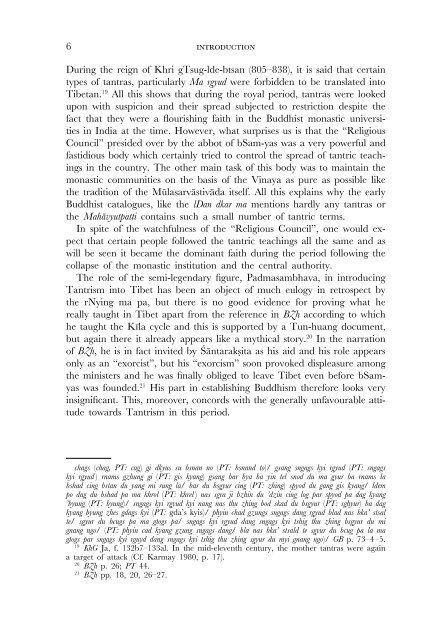You also want an ePaper? Increase the reach of your titles
YUMPU automatically turns print PDFs into web optimized ePapers that Google loves.
6 introduction<br />
During the reign of Khri gTsug-lde-btsan (805–838), it is said that certain<br />
types of tantras, particularly Ma rgyud were forbidden to be translated into<br />
Tibetan. 19 All this shows that during the royal period, tantras were looked<br />
upon with suspicion and their spread subjected to restriction despite the<br />
fact that they were a flourishing faith in the Buddhist monastic universities<br />
in India at the time. However, what surprises us is that the “Religious<br />
Council” presided over by the abbot of bSam-yas was a very powerful and<br />
fastidious body which certainly tried to control the spread of tantric teachings<br />
in the country. The other main task of this body was to maintain the<br />
monastic communities on the basis of the Vinaya as pure as possible like<br />
the tradition of the Mùlasarvàstivàda itself. All this explains why the early<br />
Buddhist catalogues, like the lDan dkar ma mentions hardly any tantras or<br />
the Mahàvyutpatti contains such a small number of tantric terms.<br />
In spite of the watchfulness of the “Religious Council”, one would expect<br />
that certain people followed the tantric teachings all the same and as<br />
will be seen it became the dominant faith during the period following the<br />
collapse of the monastic institution and the central authority.<br />
The role of the semi-legendary figure, Padmasambhava, in introducing<br />
Tantrism into Tibet has been an object of much eulogy in retrospect by<br />
the rNying ma pa, but there is no good evidence for proving what he<br />
really taught in Tibet apart from the reference in BZh according to which<br />
he taught the Kìla cycle and this is supported by a Tun-huang document,<br />
but again there it already appears like a mythical story. 20 In the narration<br />
of BZh, he is in fact invited by •àntarakßita as his aid and his role appears<br />
only as an “exorcist”, but his “exorcism” soon provoked displeasure among<br />
the ministers and he was finally obliged to leave Tibet even before bSamyas<br />
was founded. 21 His part in establishing Buddhism therefore looks very<br />
insignificant. This, moreover, concords with the generally unfavourable attitude<br />
towards Tantrism in this period.<br />
chags (chag, PT: cag) gi dkyus su bsnan no (PT: bsnand to)/ gsang sngags kyi rgyud (PT: sngags<br />
kyi rgyud ) rnams gzhung gi (PT: gis kyang) gsang bar bya ba yin tel snod du ma gyur ba rnams la<br />
bshad cing bstan du yang mi rung la/ bar du bsgyur cing (PT: zhing) spyod du gang gis kyang/ ldem<br />
po dag du bshad pa ma khrol (PT: khrel ) nas sgra ji bzhin du ’dzin cing log par spyod pa dag kyang<br />
’byung (PT: byung)/ sngags kyi rgyud kyi nang nas thu zhing bod skad du bsgyur (PT: sghyur) ba dag<br />
kyang byung zhes gdags kyi (PT: gda’s kyis)/ phyin chad gzungs sngags dang rgyud blad nas bka’ stsal<br />
te/ sgyur du bcugs pa ma gtogs pa/ sngags kyi rgyud dang sngags kyi tshig thu zhing bsgyur du mi<br />
gnang ngo/ (PT: phyin cad kyang gzung sngags dang/ bla nas bka’ stsald te sgyur du bcug pa la ma<br />
gtogs par sngags kyi rguyd dang sngags kyi tshig thu zhing sgyur du myi gnang ngo)/ GB p. 73–4–5.<br />
19 KhG Ja, f. 132b7–133al. In the mid-eleventh century, the mother tantras were again<br />
a target of attack (Cf. Karmay 1980, p. 17).<br />
20 BZh p. 26; PT 44.<br />
21 BZh pp. 18, 20, 26–27.

















